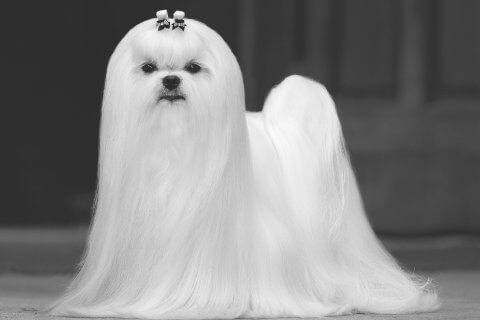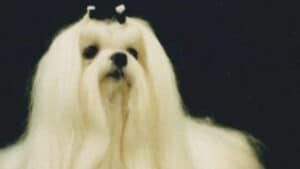
Topknot History
Discover the evolving history of Maltese topknots and the shift from simple styles to exaggerated fashion trends.
Home » Meet The Breeds » Maltese
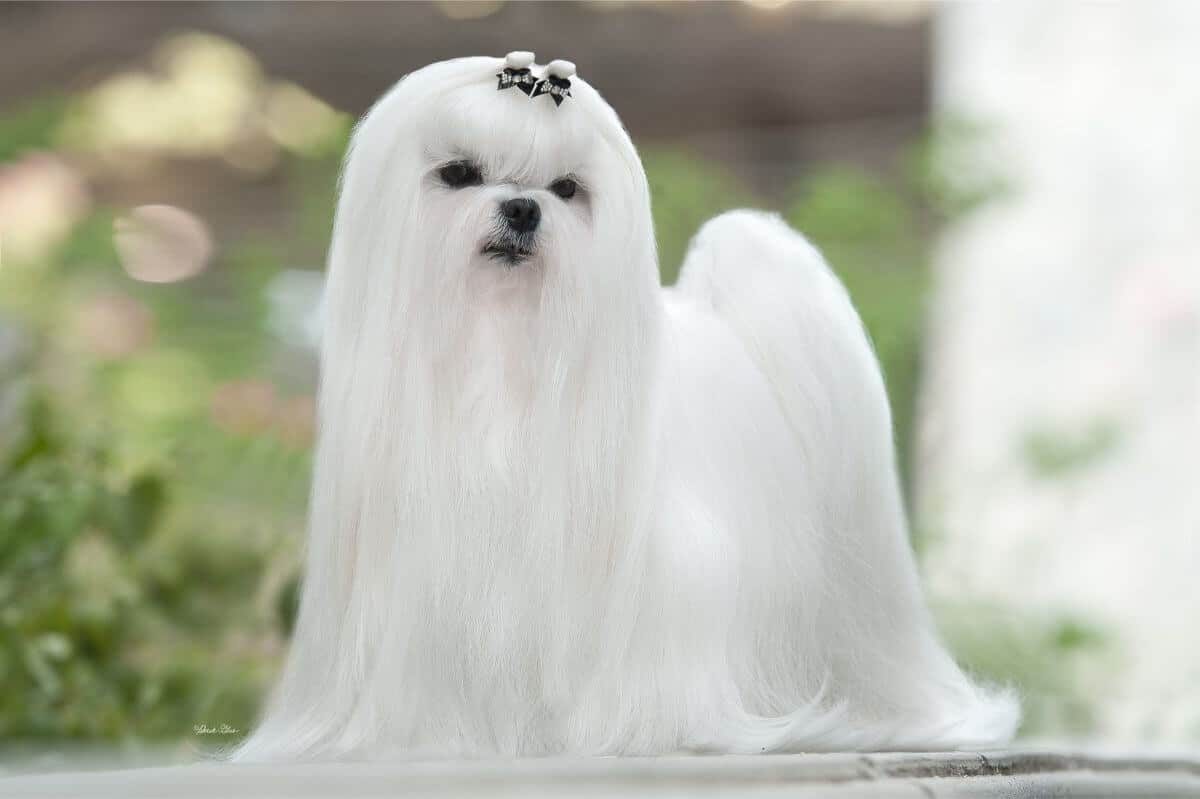
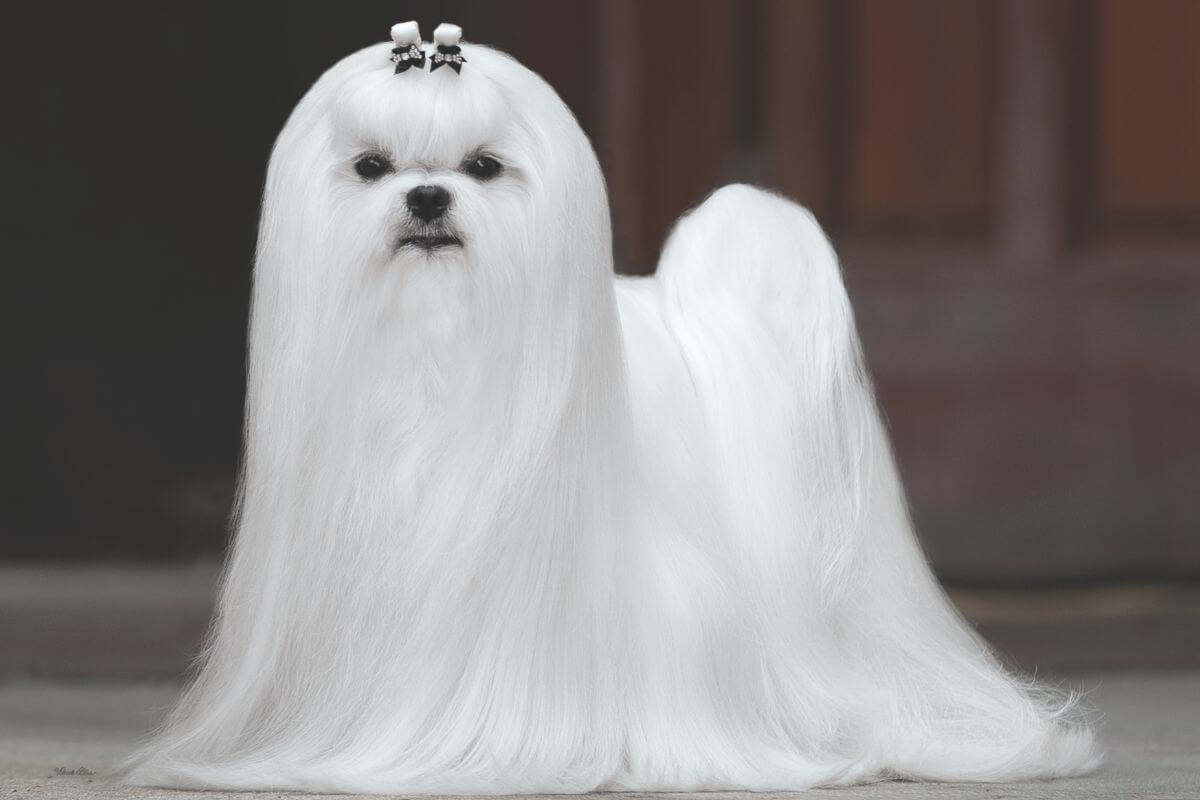
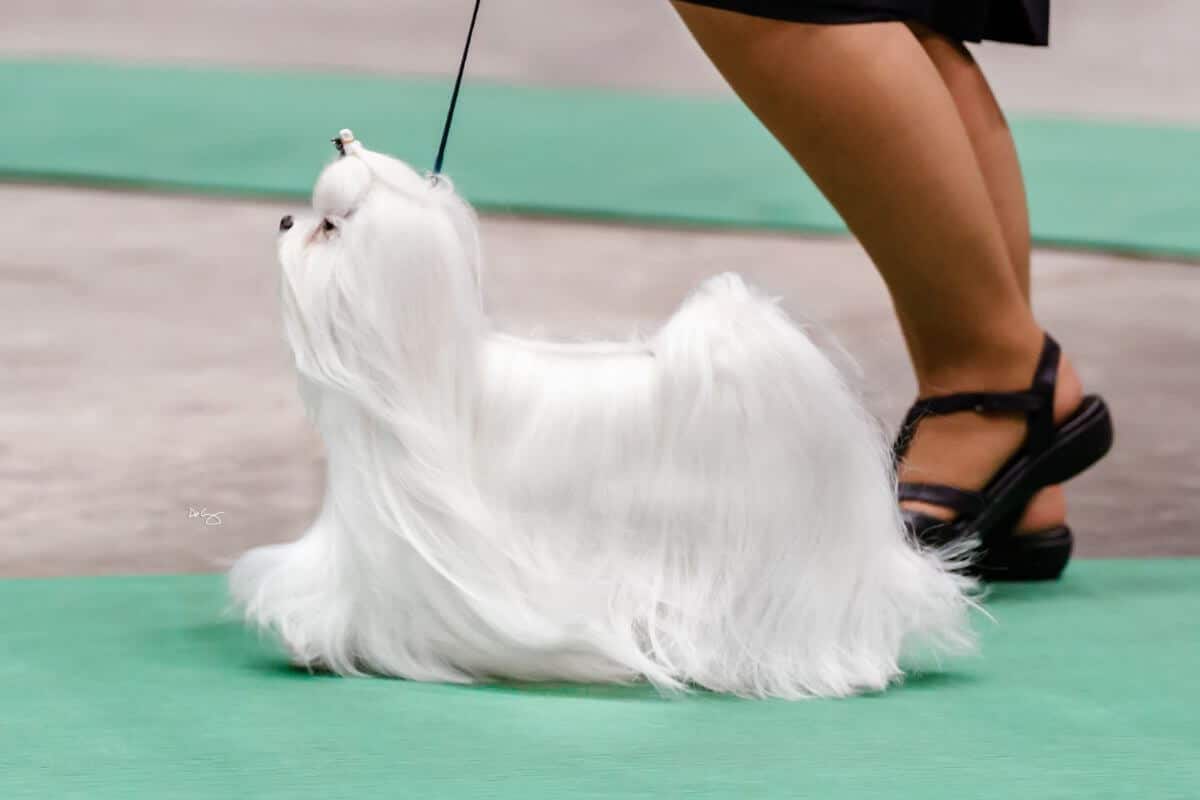
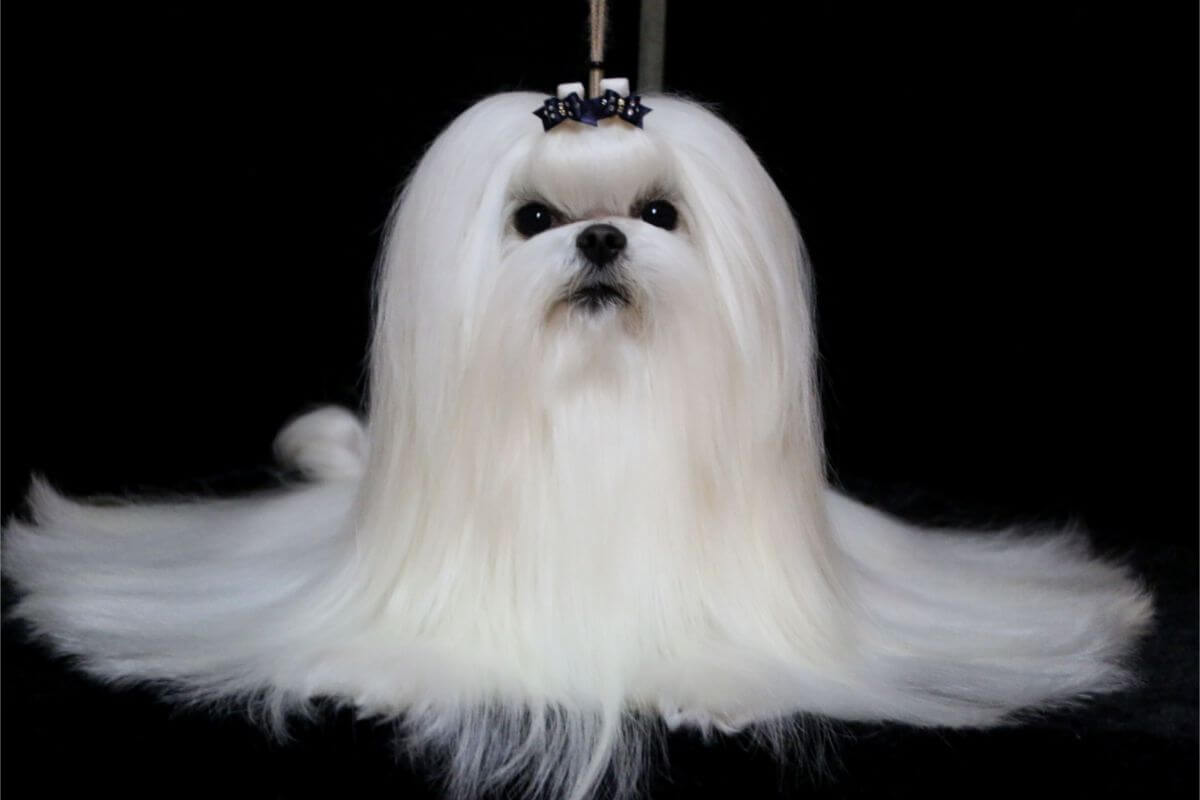
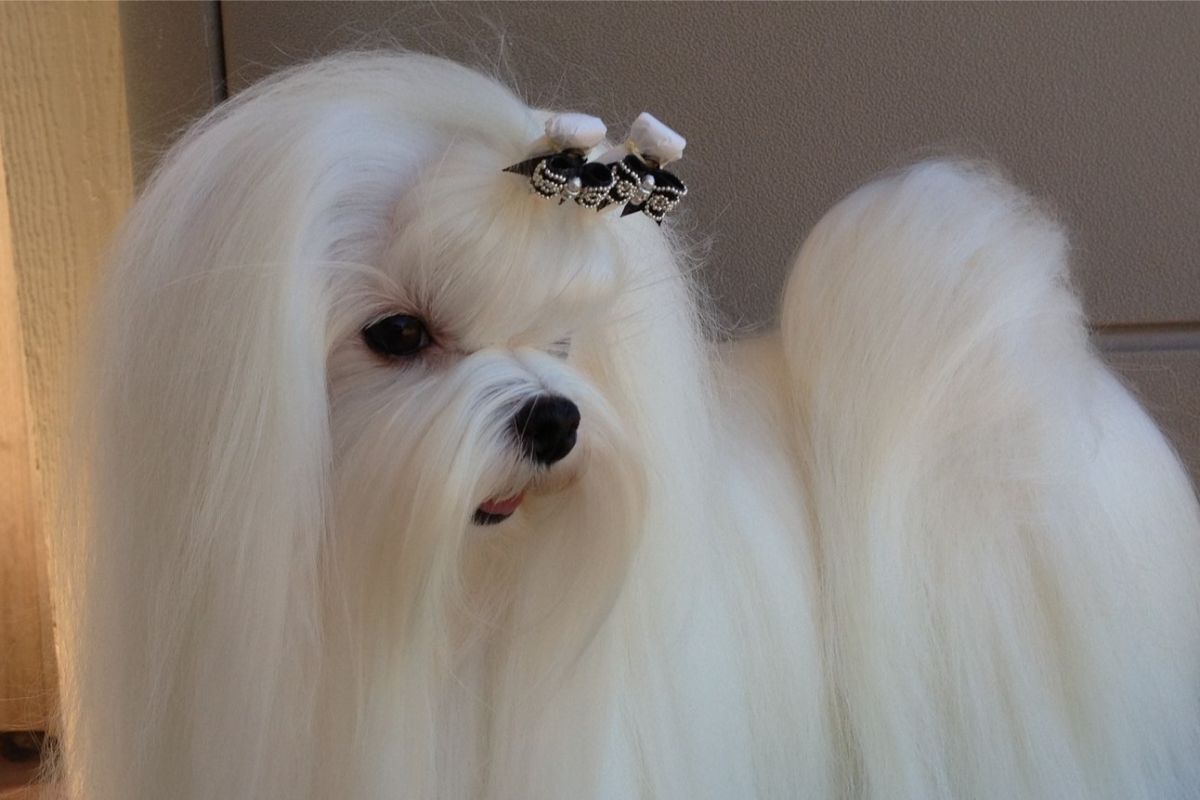
The Maltese is a petit purebred of ancient origin that hails from the Mediterranean Sea. Admired for centuries for its silky, white coat and affectionate nature, this playful yet fearless breed has graced the laps of dog lovers from Corfu to Croatia and from Cyprus to Sicily. The island of Malta, however, gave this distinctive breed its name. A favorite today among those who admire small dogs with big personalities, the Maltese remains a beloved companion in the home and a shining star in the show ring.
Toy
7 – 9 inches
under 7 pounds
12 – 15 years
| Country of Origin | Malta |
|---|---|
| Bred For | Companionship |
| Known For | Affection, Playfulness, Trainability |
| Popularity | High |
| Temperament | Playful, Charming, Gentle |
| Activities | Running, Walking, Conformation Shows, Dog Sports, Mental Stimulation |
The Maltese is one of the oldest of all Toy breeds, with a history that can be traced back over two millennia. The breed has been the companion of choice for royalty and nobility throughout the ages, valued for its beauty, elegance, and exceeding charm.
The origins of the Maltese are believed to be in the maritime cities of the central Mediterranean. This includes port cities on the island of Malta, hence the breed’s name. The ancestors of those early dogs were likely small, spitz-type companions that were then selectively bred to achieve the diminutive size and luxurious coat that is seen today.
Historical records and artistic representations suggest the Maltese was a favored pet among the ancient Greeks, Romans, and Egyptians. Notable figures such as the Roman Emperor Claudius and the Greek philosopher Aristotle mentioned (or alluded to) the breed in their writings, highlighting the dogs’ esteemed status in ancient societies.
The breed’s purpose has always been that of a companion. Unlike so many of today’s purebreds, the Maltese was not bred for hunting, herding, or guarding. Rather, these dogs were strictly kept for the pleasure and comfort of their human companions. The breed’s gentle and affectionate nature made it particularly popular among ladies in aristocratic circles.
The official recognition of the Maltese by major kennel clubs came about centuries later. The American Kennel Club (AKC) recognized the breed in 1888. The Fédération Cynologique Internationale (FCI) and The Royal Kennel Club (UK) have also recognized the breed, further securing its status as a beloved companion worldwide.
Over millennia, the Maltese has remained a symbol of luxury and refinement. Despite changes in its appearance over time, this delightful and diminutive breed has retained its status as a highly prized and cherished companion dog, beloved for its beautiful coat, expressive eyes, and loving temperament.
An adult Maltese typically stands from 7 to 9 inches tall at the shoulder. In terms of weight, a healthy adult Maltese generally weighs less than 7 pounds, presenting a compact and lightweight physique that is consistent across both genders.
The Maltese is characterized by its balanced and well-proportioned body, exuding an appearance of grace and elegance. Despite the breed’s small stature, these little dogs possess a compact yet sturdy build. Their substance is sufficient enough to provide a feeling of solidity, with well-sprung ribs and a level topline. This harmonious blend of proportions contributes greatly to the breed’s distinctive appearance as well as its sprightly and light-footed movement.
Texture: The beautiful coat of the Maltese is one of the breed’s most distinctive features. It is a single coat of long, flat, and silky hairs that fall gracefully (almost) to the ground, giving this dog its elegant and aristocratic appearance. There is no undercoat. The straight coat bears no suggestion of a curly, kinky, or woolly texture, though it does require considerable grooming to prevent tangles and to maintain both its length and its luster.
| Standard Color | |
|---|---|
| White | y |
| White & Lemon | n |
| White & Tan | n |
| Standard Marking | |
|---|---|
| Black Points | ee |
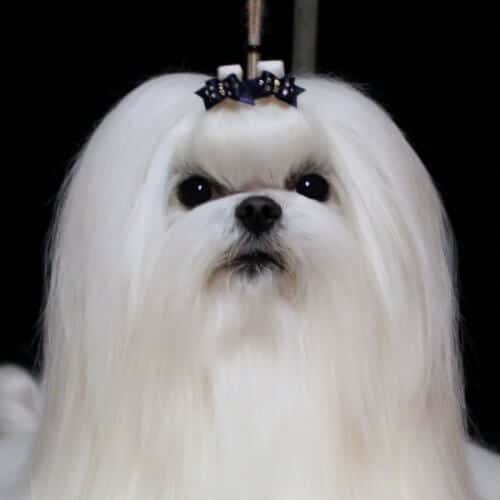
The tail of the Maltese is set high and arches gracefully over the dog’s back. The tip lies to the side over the hindquarters, and the entire tail is covered with long, flowing hair that falls on either side. The impression made is altogether delightful and reflects the breed’s pride of heritage and its lively personality.
The tail of the Maltese is an essential part of the breed’s natural beauty, and its graceful carriage is indicative of the fearless and affectionate nature of this most exquisite and ancient purebred.
Sharing life with a Maltese can be an endlessly delightful experience for people who appreciate beautiful dogs in small white packages. Known for their affectionate nature and small size, these diminutive creatures are particularly well-suited for companionship (and spoiling) thanks to their playful and gentle nature. However, prospective owners of this breed should be aware of the specific needs and responsibilities that come with caring for such a unique and captivating canine.
The Maltese is generally a healthy and hardy breed, enjoying a relatively long lifespan. Despite their diminutive size, these dogs are typically very resilient. With proper care, they can maintain good health and vitality for many years.
The average lifespan of a Maltese ranges from 12 to 15 years. Regular veterinary check-ups, a balanced diet, and proper grooming are crucial in maintaining the health and well-being of the dog.
Like all breeds and mixed breeds, the Maltese can be prone to certain health conditions. Being aware of these potential issues is essential for early detection and treatment. Common health concerns in Maltese include:
Regular visits to the veterinarian are vital for the early detection and management of these health issues. In addition to routine wellness exams, specific screenings for eye, knee, and liver health are recommended for the Maltese. By staying informed and proactive about these potential health risks, owners can help their dogs live long, happy, and healthy lives.
The Maltese is renowned for its gentle, affectionate, and responsive nature, making it an excellent companion for a variety of people, including those who are relatively new to dog ownership. These small dogs are known for their loving and loyal demeanor, forming strong bonds with their human companions.
Sensitivity is a notable trait in the Maltese; these dogs respond well to positive reinforcement and gentle training methods. Harsh words or actions can easily upset them, so a kind and consistent approach works best. Their sensitive nature also means they may not tolerate being left alone for extended periods. Maltese thrive on companionship and interaction, making them less suited for households where they would spend too much time by themselves.
In terms of compatibility with other pets and children, the Maltese generally does well. These dogs usually get along well with others and can coexist peacefully with household pets if socialized properly from a young age. However, due to their small size, interactions with very young children should always be supervised to make sure the dog isn’t accidentally injured.
Despite the breed’s small stature, the Maltese can be quite spirited and playful, enjoying interactive games and activities. The friendly nature of these dogs typically extends to strangers as well, though they may initially show some reservation. Early socialization is key to helping them become well-adjusted, confident adult dogs, comfortable in various situations and with different people.
While the Maltese can be a joy to train due to the breed’s intelligence and eagerness to please, potential owners should be aware of the dogs’ tendency to bark. They may alert to notify you of strangers or unusual occurrences, which may not always be desired. This tendency can be managed with proper training and socialization. The breed’s intelligent and curious nature tends to makes the Maltese a quick learner; however, these little lap dogs can also have a bit of a stubborn streak, so patience and consistency are crucial in training.
Proper nutrition is essential for the health and well-being of a Maltese. Given the breed’s small size, the dietary needs of these dogs can be quite specific, so it’s important to provide them with a balanced diet that meets their unique requirements.
When it comes to feeding a Maltese puppy, it’s crucial to offer high-quality puppy food that’s formulated for small breeds. Puppies have higher energy levels, so their diet should be rich in proteins and fats to support their growth and development. Feeding small, frequent meals—typically three to four times a day—is recommended to support their fast metabolism.
As a Maltese transitions into adulthood, its dietary needs will change. Adult dogs should be fed a high-quality dog food suitable for their age, size, and activity levels. The amount of food they require can vary based on their individual metabolism and activity, but generally, an adult will need about ¼ to ½ cup of dry dog food per day, divided into two meals. This should prevent overfeeding, which is crucial, as small breeds like the Maltese can be prone to obesity.
It’s important to monitor the weight of a Maltese and adjust the food intake accordingly. Treats should be given in moderation and should not make up more than 10 percent of a dog’s total calorie intake. Fresh water should always be available, as proper hydration is vital for maintaining a dog’s overall good health.
Given the breed’s small size, individual Maltese can also have specific preferences or sensitivities when it comes to food. Some may prefer wet food or a combination of wet and dry, while others may require special diets due to health issues like allergies or sensitivities. Consulting with the dog’s breeder and a veterinarian can help to determine the best dietary plan for a Maltese, making sure the dog receives all the nutrients necessary for its health and happiness.
Training a Maltese, a breed known for its intelligence and desire to please, can be a rewarding experience for both the dog and its handler. These small wonders are generally quick to learn and are responsive to positive reinforcement techniques, making them well-suited for both novice and experienced dog owners.
One of the key aspects of training a Maltese is to start early. Puppyhood is the ideal time to begin basic obedience training, as it sets a foundation for good behavior and helps in socializing the dog. This breed, with its sharp intellect, often picks up commands quickly. Consistency is crucial for reinforcing these lessons.
Despite their small size, Maltese can have a tendency to bark. This natural alertness makes them excellent watchdogs, but it can become excessive if not managed properly. Training them to understand commands such as “quiet” or “no bark” is important, as is understanding the root cause of the barking, whether it’s due to excitement, anxiety, or alerting to strangers.
In terms of intelligence, the Maltese ranks high. These dogs are adept at learning tricks and enjoy engaging activities that challenge their minds. Puzzle toys and games that stimulate their intellect can be beneficial and enjoyable for them.
However, like many breeds, the Maltese can show a streak of independence, which may sometimes be mistaken for stubbornness. This trait calls for a patient and gentle approach to training. Harsh methods or scolding can be counterproductive, as the Maltese responds best to positive reinforcement and encouragement.
While Maltese may not be as prone to roaming as some larger breeds, it’s still important to provide a safe and secure environment. Exercise caution when training outdoors. Adequate fencing and continuous supervision are essential for keeping them safe whenever they’re outside.
Maltese may chase smaller animals, but only due to their playful nature. and not because of any predatory instinct. Training these dogs to come when called, and to stay close to their handler during walks, is essential for their safety.
The exercise needs of a Maltese, while not as demanding as those of larger, more energetic breeds, are still an important aspect of their care. These small dogs possess a moderate level of energy, which can be satisfied with daily walks and playtime. Regular exercise not only helps in keeping them physically fit, it also plays a crucial role in their mental development and general happiness.
| Energy Level | Moderate to High |
|---|---|
| Exercise Requirements | 30 Minutes/Day (Minimum), Daily Walks, Vigorous Running, Regular Exercise, Mental Stimulation |
In terms of exercise, a Maltese does not require extensive physical activity. Short walks combined with some playtime throughout the day are usually sufficient to meet the dog’s needs. However, it’s important to tailor the exercise routine to the individual’s age, health, and energy level. Puppies and younger dogs will likely have more energy and require more playtime, while older dogs may prefer more leisurely walks.
The intensity of the exercise should be moderate. Due to their small size, Maltese can tire easily, so it’s important to avoid overly strenuous activities. They enjoy gentle play and short walks where they can explore their surroundings at a comfortable pace.
Playfulness is a key trait of the Maltese. They often enjoy interactive games with their human companions, such as fetch or a very gentle tug-of-war. These activities not only provide physical exercise but also strengthen the bond between the dog and its caretaker.
While the Maltese can adapt to various living situations, including apartments, they still need regular opportunities to move around and explore. Even in a small space, it’s important to provide these dogs with toys and activities that keep them engaged and active.
Despite the breed’s adaptability, the Maltese is not a dog that tolerates extreme weather conditions well. In hot weather, it’s important to make sure they do not overheat and provide them with access to shade and water. In colder climates, they may require a sweater or coat to stay warm during walks.
Grooming a Maltese is an essential aspect of care, given the breed’s distinctively long and silky coat. Consistent and detailed grooming are necessary to preserve the health and appearance of the coat, as well as to maintain the dog’s comfort and general well-being.
| Coat Type | Long, Flat, Silky |
|---|---|
| Grooming Requirements | Daily Combing, Weekly Brushing, Occasional Bathing, Routine Ear Cleaning, Periodic Nail Trimming, Regular Tooth Brushing |
One of the main grooming requirements for a Maltese is regular brushing. The breed’s long, luxurious coat can easily become tangled or matted if not brushed frequently. It is advisable to brush the coat daily to prevent tangles and to keep it clean and glossy. Using a soft bristle brush or a comb specifically designed for long-haired, drop-coated breeds can make this process more effective and comfortable for the dog.
In terms of shedding, the Maltese is known to be a low shedder. The hair of these dogs grows continuously, much like human hair, and there’s no undercoat, which means they shed less than many other breeds. This trait makes them a good choice for people with allergies, as there is less dander and hair in the environment. However, regular grooming is still necessary to remove the loose hairs and prevent matting.
Bathing is another important aspect of grooming a Maltese. Due to the breed’s white coat, these dogs may require frequent baths to keep them looking clean and bright. Using a high-quality dog shampoo and conditioner can help to keep the coat soft and in good condition. It’s important, however, to make sure the shampoo is thoroughly rinsed out to avoid any skin irritation.
In addition to coat care, other grooming needs include regular nail trimming, as long nails can cause discomfort and affect the dog’s gait. Ear cleaning is also important, especially since the breed’s hanging ears can be prone to infections if not kept clean and dry. Regular dental care, including tooth brushing and professional cleanings, is crucial to prevent any dental issues, which can be common in small breeds like the Maltese.
Living with a Maltese can be a uniquely rewarding experience, but it also involves specific considerations to support the dog’s well-being and happiness in a home environment. This breed, known for its adaptability and affectionate nature, is well-suited for a variety of living environments, including both apartments and larger homes.
The breed’s small size makes the Maltese an ideal choice for apartment living, as these dogs don’t require a large amount of space. However, despite their adaptability to smaller living areas, it’s important to provide them with regular exercise and mental stimulation. Daily walks and play sessions are essential to keep them physically fit and mentally engaged.
In terms of weather adaptability, the Maltese is somewhat sensitive. They can struggle in extreme temperatures, so they might need the extra warmth of a sweater or coat in colder temperatures. During hot weather, they should be kept cool and protected from overheating when outside for extended periods.
Maltese thrive on companionship and do not fare well when left alone for any duration. This breed can develop separation anxiety, which could lead a dog to exhibit undesirable behaviors such as excessive barking or destructiveness. Therefore, an environment that offers frequent interaction, whether with their human family members or other pets, is best for these gregarious and gentle-mannered dogs.
The arrival of Maltese puppies is the beginning of a journey that’s filled with joy. These delightful babies, known for their boundless energy and affectionate nature, will become integral members of their new families. Nurturing them is an engaging experience, one that requires dedicated attention to help them develop into healthy and well-adjusted adults.
Caring for a Maltese puppy involves a comprehensive approach, focusing on the pup’s physical, mental, and emotional development. From the moment a puppy leaves for its new home, it requires careful nurturing to flourish.
A balanced diet tailored for small breed puppies is crucial for a Maltese puppy’s growth. This breed has specific nutritional needs, so feeding a high-quality puppy food helps in the pup’s development. The feeding schedule should be consistent, with meals divided into small portions throughout the day to support digestion and rising energy levels.
Early socialization and training are vital for the Maltese puppy. Introducing the pup to various people, environments, and other animals helps in developing social skills and an outgoing temperament. Positive reinforcement techniques work best for training, as this breed is sensitive and responds well to gentle guidance. Teaching basic obedience and housebreaking from the start will lay the foundation for a well-behaved adult dog.
Healthcare is another critical aspect of raising a Maltese. Regular veterinary check-ups, vaccinations, and deworming are necessary to protect the puppy from many common health issues. With its delicate size, the Maltese puppy can be prone to certain conditions, so close monitoring is important throughout the first year. Dental care should also be initiated early, as good oral hygiene is crucial for preventing dental problems later in life.
Since the Maltese thrives on togetherness, it’s important to spend quality time together throughout its puppyhood. However, to prevent separation anxiety from becoming an issue, it can be a good idea to gradually allow the pup to be left alone for short periods at a time.
The Maltese, while primarily known as a diminutive companion dog, can also excels in a variety of dog sports. These activities not only provide physical and mental stimulation, they also strengthen the bond between the Maltese and the handler. Here are some activities and dog sports in which Maltese can participate:
Participating in these organized activities and sports can provide valuable physical exercise, mental stimulation, and socialization opportunities for a Maltese. It also allows owners to explore and develop their dog’s natural abilities and interests, further enhancing the bond they share.
The Maltese is recognized by the world’s leading registries and kennel organizations, which categorize the breed into a specific Group based on its unique characteristics. This breed is recognized worldwide under the following Group designations:
| Organization | Group Designation |
|---|---|
| AKC (American Kennel Club) | Toy |
| UKC (United Kennel Club) | Companion Dog |
| CKC (Canadian Kennel Club) | Toys |
| ANKC (Australian National Kennel Council) | Toys |
| RKC (The Royal Kennel Club) | Toy |
| FCI (Fédération Cynologique Internationale) | Group 9: Companions and Toy Dogs; Section 1: Bichons and Related Breeds |
The ideal Maltese is described by a Breed Standard that is approved by each of the world’s leading registries and kennel organizations. The Breed Standards for this breed may be found in the following links:
| Organization | Breed Standard |
|---|---|
| American Kennel Club | AKC Maltese Breed Standard |
| United Kennel Club | UKC Maltese Breed Standard |
| Canadian Kennel Club | CKC Maltese Breed Standard |
| Australian National Kennel Council | ANKC Maltese Breed Standard |
| The Royal Kennel Club | RKC Maltese Breed Standard |
| Fédération Cynologique Internationale | FCI Maltese Breed Standard |
Breed clubs are integral for supporting and celebrating the ancient Maltese as a distinct breed. They provide a platform for enthusiasts to engage in breed-specific activities, share knowledge, and promote responsible ownership and breeding practices.
In the United States, the American Maltese Association (AMA) is the AKC-recognized parent club for the breed. The AMA was formed in the early 1960s from the merger of two national Maltese clubs: The Maltese Dog Club of America and the Maltese Dog Fanciers of America. The current organization is dedicated to the betterment of the breed, focusing on health initiatives, responsible breeding practices, and education. The AMA organizes a variety of events, including Conformation shows and educational seminars, providing a valuable resource for Maltese owners and breeders across the country.
In the United Kingdom, The Maltese Club, established in 1934, is one of the oldest breed-specific clubs. This organization plays a significant role in the promotion and preservation of the breed in the UK, and its members organize events and dog shows that can offer guidance and support to Maltese breeders and owners.
These Maltese clubs, among others worldwide, play a crucial role in maintaining Breed Standards and safeguarding the welfare of the breed. They offer invaluable resources for anyone interested in this lively and playful breed, including seasoned breeders, first-time Maltese owners, and anyone else who admires this elegant little dog.
Rescue groups play a vital role in providing care and finding new homes for Maltese in need. While breed-specific rescue organizations may not be as widespread as those for some other breeds, there are dedicated groups that focus on the welfare of these delightful dogs.
In the United States, several local rescue groups specialize in the needs of Maltese. These organizations, such as the Metropolitan Maltese Rescue in New York and Southern Comfort Maltese Rescue, work tirelessly to provide care, rehabilitation, and rehoming services for Maltese in need. Their volunteers operate primarily in specific regions, offering a network of support that includes foster care, medical treatment, and assistance in finding permanent homes for needy dogs.
In the United Kingdom, The Maltese Club occasionally assists Maltese that are in need of finding a new forever home. These groups offer essential services for any Maltese that requires rehoming due to changes in the owner’s circumstances, abandonment issues, or any other reason.
For those in regions without a rescue group for Maltese, local animal shelters and all-breed rescue organizations can be reliable resources. Shelters and rescue groups can sometimes have a Maltese that’s available for adoption. Depending on the timing, these facilities might be able provide an opportunity to give a loving home to a local Maltese.
Maltese are known for their minimal shedding. Their long, silky coat does not have an undercoat, which significantly reduces the amount of hair that’s shed. This trait makes them an appealing choice for people with allergies or those who prefer a breed with minimal shedding.
Maltese typically have a long lifespan, often living from 12 to 15 years. Some individuals can live even longer, especially when provided with excellent care that includes a balanced diet, regular veterinary check-ups, and a healthy living environment.
While no dog is completely hypoallergenic, Maltese are often considered a good option for allergy sufferers. The breed’s lack of an undercoat and minimal shedding means they release fewer allergens into the environment when compared to many other breeds.
Maltese can be vocal and may bark more than some other breeds. These lively little dogs often bark to alert their human companions of unfamiliar activity or sounds. However, with proper training and socialization from a young age, excessive barking can usually be managed and minimized.
Historically, Maltese were bred primarily for companionship. They have always been favored as lap-dogs and companions among the aristocracy and royals, prized for their beautiful appearance and affectionate nature rather than for any working ability.
Maltese are intelligent and responsive dogs. They are quick to learn and can be easily trained, especially when positive reinforcement techniques are used. Their intelligence makes them adept at learning tricks and commands.
Common causes of death in Maltese include age-related diseases such as heart problems and cancer. They may also be prone to certain breed-specific health issues like dental problems, liver shunt, and respiratory conditions, which can impact their longevity.
Maltese typically stop growing in size by the age of 6 to 8 months. However, they may continue to fill out and gain muscle until they are about a year old. Their emotional and behavioral maturity can take a bit longer, often reaching full maturity around 18 months of age.
Maltese can be good with children, especially when raised with them and properly socialized. However, due to the breed’s small size, interactions with very young or boisterous children should be supervised to prevent accidental injury to the dog.
Maltese make excellent family dogs for those who can meet their needs. Most are affectionate and loyal, and they enjoy being part of family activities. Their small size and moderate exercise needs make them suitable for a variety of lifestyles today.

Discover the evolving history of Maltese topknots and the shift from simple styles to exaggerated fashion trends.

Natalya Ignatyeva of Diamond Stars shares her insights on Maltese, show puppy selection, breed trends, and the dog show community.

Melissa Robison is the breeder behind Alexis Maltese. Read about the kennel’s beginnings, the sires, the dams, the puppies, and much more!

Victoria Chedygov is the breeder behind the Vellavica Maltese. Read about the kennel’s beginnings, the sires, the dams, the puppies & more!
The best way to ensure a long and happy relationship with a purebred dog is to purchase one from a responsible breeder. Not sure where to begin?
Contact the National Parent Club’s Breeder Referral Program, which is listed on the AKC Breeder Referral Contacts page.
